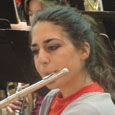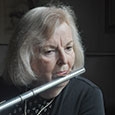
I attended music camp for the first time when I was 10 years old. Sponsored by Texas Technological College in Lubbuck, Texas, the camp still exists, only now the college is a university. The experience changed my life, as it started me on a lifelong quest to figure out how to play the flute.
This year I taught summer camp for the 40th time, and found that it is still changing my life and the lives of students. On the final day this summer, the Sewanee Summer Music Festival 2010 flute studio assembled for one more masterclass, and we invited parents and friends to join us. We performed several chamber works, sightread a new work by a student composer, and briefly talked about what we had studied during the past four weeks.
My studio has white boards on two sides of the room, and each time a new concept or tone exercise was presented during the summer, I wrote it on the white boards. After four weeks, they were filled with information. During the final session, I noticed several of the flutists photographing the boards with their cell phones. One board included the philosophy of chunking as a practice device, names of several must-read authors, and an exercise on “blooming” the tone.
The other board listed 13 basic rules of phrasing and a rather extensive chart of the musical style periods, including the names of representative composers. (We had referenced the rules of phrasing list so many times, by the fourth week, I could say: number 2, and the flutist knew exactly what I meant.)
There is a teaching theory that says you haven’t taught until your students have learned. During this final masterclass, I asked the students what the most important lesson was that they had learned during the summer, and their answers were extraordinary. These flutists had learned. It was also clear that they had learned a lot merely through observation, rather than just those concepts that I had officially introduced.
Concerto Performances
Two of the older flutists won the opportunity to play a concerto with the Festival Orchestra. Their comments related to how much a flutist has to project over the orchestra and how musical ideas should be formed strongly and exaggerated for the audience to hear them. Performing by memory was a worry for both, but each prepared well and met the challenge. Several of the younger flutists were inspired by the concerto performances and have already chosen concerto repertoire to learn during the school year because they want to be concerto winners next summer.
Friendship
Another of the advanced students remarked that she had learned to get along with her colleagues. When asked what she meant, she added “in a musical setting.” I asked, “Does this mean that you no longer want to kill the oboe player when the pitch is not where you want it to be?” She laughed and nodded yes.
Playing in an orchestra is an ensemble experience. To be a contributing member of an ensemble is a give-and-take situation. The goal is not to get your way, but to think about the quality of the overall performance and what you can do to achieve that goal. So, if the oboe player’s E is always sharp, make yours sharp too when playing in unison. Better to hear a sharp E rather than two distinct pitches.
Playing Second Flute
Another flutist commented that she had learned to play second flute. On the surface this may not seem to be a lot, but it is a huge accomplishment. The roll of a second flutist is to compliment and support the first player. The first player gets to make the choices about dynamics, tone color, tempo, style, vibrato, and length of a note, and the second flutist’s job is to implement those choices, whether they agree with them or not.
At Sewanee the flutists rotate between playing first flute or assistant, second flute or assistant, and piccolo. Within an hour-long concert, a flutist will be the leader on one composition and a follower on the next. The daily coached chamber music sessions also present the opportunity for students to learn how to be a supporting member of an ensemble and also play the solo lines – ideas that carry over to orchestral playing as well.
Most students were surprised to learn that there are three levels of each of the following dynamics: pp, p, mp, mf, f, ff. There is the solo p that is the loudest, the accompanying p that is the softest, and the section or tutti p, which is in between. This certainly puts the burden on each individual to play at the correct dynamic level. Learning to use your ears is the goal.
Style Period Considerations
Several of the younger students knew that the composers they were performing lived in varying historical times, but how this knowledge related to musical style and the flute was a mystery. This is not uncommon for flutists today, as most perform in a band or wind ensemble where the repertoire is predominantly contemporary.
On the white board I wrote the names of the four major style periods in which the flute is involved – the Baroque (1600–1750), Classic Era (1750–1827), Romantic (1800–1900) and Contemporary (1900–present). Under each period I wrote the names of the major composers. During chamber music sessions, as we performed a composition from one of the style periods, we discussed the characteristics of that style.
For example, in the Baroque, when composers indicated dynamics, they used either piano or forte. During the Classical Era, six dynamic markings were used: pp, p, mp, mf, f, ff. During the Romantic period ppp and fff were added. In the contemporary era, there may be a dynamic under each note. A musician can almost tell when a piece was written by the use of the dynamics.
In connecting notes, we used the terms glued and unglued. In the treatise On the Playing of the Flute (1752) J. J. Quantz wrote, “The notes must not appear to be glued together.” I related that a famous harpsichordist, when asked about note length, replied that the note length should be as if you were playing each note with one finger. This natural separation is what we should strive for in articulated Baroque music.
Closer to the Romantic period of music, the notes are more glued together. Learning this distinction is a big step in becoming an accomplished musician. We also discussed that Baroque and Classical music relate strongly to dancing; the strength of the beat rule should be followed. Musicians call this “coming from the beat.” In playing Romantic music, the music is about singing and “going to the beat.”
Practice
Most of the students already had a lesson/practice notebook when they arrived. However, they still were not always sure what they should practice and what practice technique to use for a specific passage.
Referencing the Robert Jourdain book Music, the Brain and Ecstasy, we explored eye movement when reading one line of music. Because the human eye sees in a one-inch fixation or segment, chunking followed by a rest is a good practice technique to use.
Chunking music three times a day for five days is the best plan to learn a difficult passage quickly. On the sixth day, play the passage at performance tempo. Week after week a camp student expressed his surprise at how well the chunking theory worked.
Posture
Many of the students had not realized that the flute is played asymmetrically. This means we should stand with the left foot in front (12:00) and the right foot in back comfortably pointed to approximately 3:00. Another way to think of this setup is to stand as if you are serving a tennis ball. In relationship to the music stand, the body is turned to the right about 45 degrees and the head is turned to the left facing the music stand. Sitting in a chair, follow the same rules, only the chair should be turned 45 degrees to the right for comfort’s sake. The flute is balanced parallel to the music stand. I insisted that each flutist had his own music and music stand, which made more room between each flutist possible. One end-of-the flute in front and the next flute in back, as in many bands, is not desireable.
Vibrato
A student from France was a lovely player, but her tone lacked vibrato. I asked if the flutist professors at her local conservatoire taught vibrato and she said no. After practicing a week of vibrato exercises George style, she played with fantastic expressive vibrato. She was excited to return to her orchestra and play with vibrato.
Teaching vibrato is simple: start on the headjoint with hah, hah, hah, rest staccato until you are comfortable. Then alternate a set of staccato hah, hah, hah, rest with a set of slurred hah, hah, hah, rest.
The American flutists found it interesting that the word legato in Europe means to slur. So each time I would instruct: slur two-tongue two, I would follow with legato two-tongue two. Exploring cultural differences was a valuable experience.
Plan to Attend a Summer Camp Now
I write this article about my experiences with the 2010 Sewanee Summer Music Festival Flute class to inspire you or your students to attend a similar camp or masterclass next summer. October is a good month to research what camps are available. (Check the March 2010 Flute Talk Masterclass/
Camp Directory for ideas, also available online.)
Make an audition C.D. in November, and submit the application, financial aid forms, C.D., and letters of recommendation in December. Students who apply early are most often the ones who are accepted and receive scholarship assistance. If you are a flute teacher, October is a great time to start planning your flute camp. If you are not interested in attending a camp or hosting one, then why not consider donating money to your local school music program to send a kid to camp. It will change both your lives.
In 1970 I attended the Sewanee Summer Music Festival as a guest artist. While I was only there one week, those seven days transformed my life. The director of the festival was Dr. Martha McCrory. While the orchestras and chamber groups rehearsed for their Sunday afternoon concert, I kept thinking how this experience was so valuable. Not only was it changing the student’s lives, but when they went home, they would show their fellow students what they had learned. The program was bringing higher orchestral standards to groups across the U.S. After that week, I went home and planned my first flute camp because if one woman could do it, so could I. This past August Dr. Martha celebrated her 90th birthday. Her work is still changing lives. I owe her so much.






